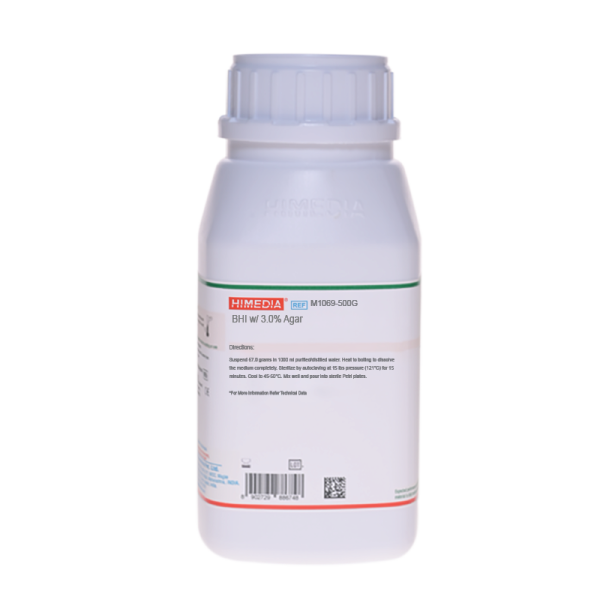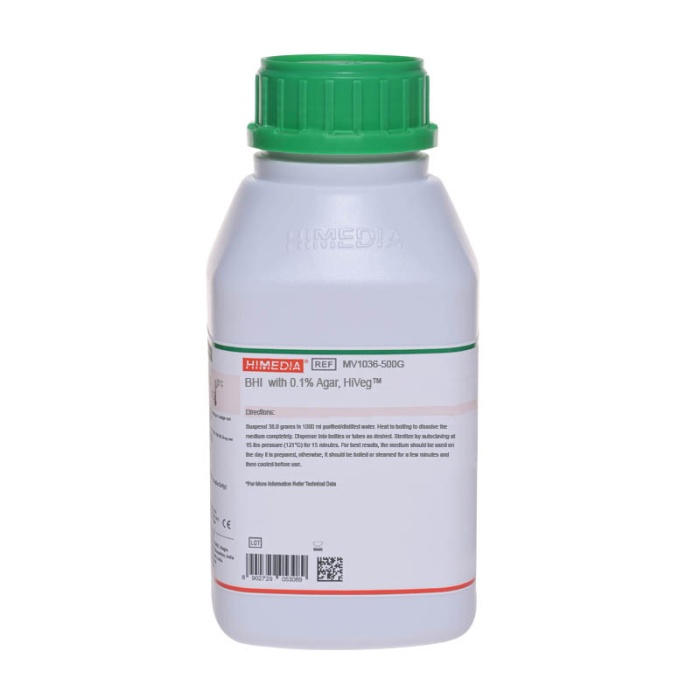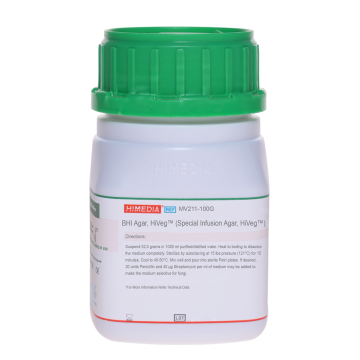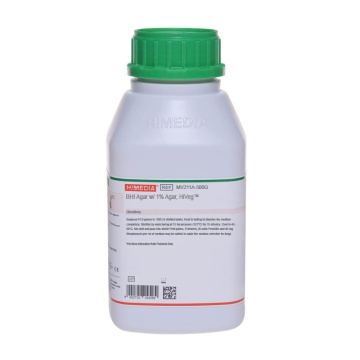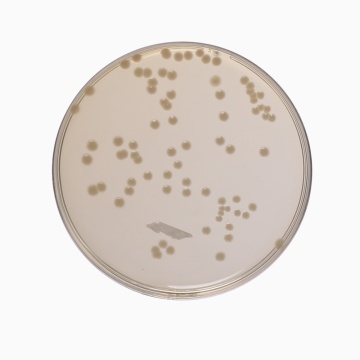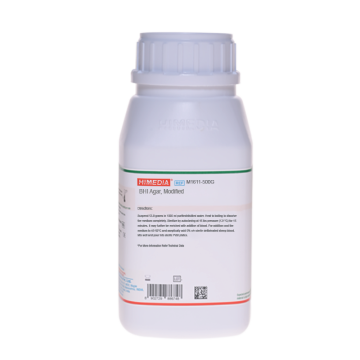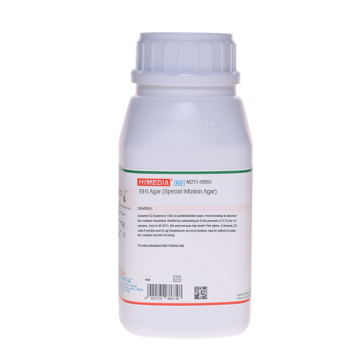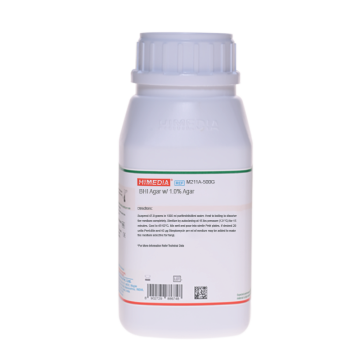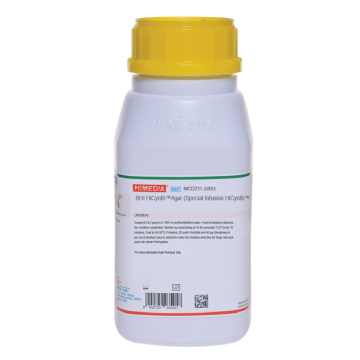 Your enquiry has been submitted
Your enquiry has been submitted
BHI Agar w/ 3.0% Agar (Brain Heart Infusion Agar w/ 3.0% Agar)
Intended Use
Recommended for cultivation of microorganisms when 3.0% Agar gel is desired.
Composition
| Ingredients | g/L |
|---|---|
| HM Infusion powder # | 12.500 |
| BHI Powder$ | 5.000 |
| Proteose peptone | 10.000 |
| Sodium chloride | 5.000 |
| Dextrose (Glucose) | 2.000 |
| Disodium hydrogen phosphate | 2.500 |
| Agar | 30.000 |
Final pH (at 25°C): 7.4±0.2
**Formula adjusted, standardized to suit performance parameters
# Equivalent to Calf brain, infusion from
$ Equivalent to Beef heart, infusion from
Directions
Suspend 67.0 grams in 1000 ml purified/distilled water. Heat to boiling to dissolve the medium completely. Sterilize by autoclaving at 15 lbs pressure (121°C) for 15 minutes. Cool to 45-50°C. Mix well and pour into sterile Petri plates.
Principle And Interpretation
This is highly nutritious medium that can support luxuriant growth of wide variety of microorganisms. It is a general purpose culture medium used for primary isolation of aerobic bacteria from clinical specimens (1). Brain Heart Infusion Agar with 3%Agar is used for cultivation of fastidious microorganisms using hard (3%) agar gel.
Proteose peptone, HM Infusion powder and BHI Powder serve as sources of carbon, nitrogen, essential growth factors, amino acids and vitamins. Dextrose serves as a source of energy. Disodium hydrogen phosphate helps in maintaining the buffering action of the medium whereas sodium chloride maintains the osmotic equilibrium of the medium.
Type of specimen
Clinical samples - pathological material such as wound swabs, faeces etc.; Food samples
Specimen Collection and Handling
For clinical samples follow appropriate techniques for handling specimens as per established guidelines (2,3).
For food samples, follow appropriate techniques for sample collection and processing as per guidelines (4).
After use, contaminated materials must be sterilized by autoclaving before discarding.
Warning and Precautions
In Vitro diagnostic use. For professional use only. Read the label before opening the container. Wear protective gloves/protective clothing/eye protection/face protection. Follow good microbiological lab practices while handling specimens and culture. Standard precautions as per established guidelines should be followed while handling clinical specimens. Safety guidelines may be referred in individual safety data sheets.
Limitations:
- As organisms differ in their nutritional requirements, some fastidious organisms may be inhibited or may show poor growth.
- Further biochemical tests must be carried out for complete identification.
Performance and Evaluation
Performance of the medium is expected when used as per the direction on the label within the expiry period when stored at recommended temperature.
Quality Control
Appearance
Cream to yellow homogeneous free flowing powder
Gelling
Firm, comparable with 3.0% Agar gel
Colour and Clarity of prepared medium
Light amber coloured clear to slightly opalescent gel forms in Petri plates.
Reaction
Reaction of 6.7% w/v aqueous solution at 25°C. pH : 7.4±0.2
pH
7.20-7.60
Cultural Response
Cultural characteristics observed after an incubation at 35-37°C for 18-24 hours.
| Organism | Inoculum (CFU) | Growth |
|---|---|---|
| Candida albicans ATCC 10231 (00054*) | 50-100 | luxuriant |
| Escherichia coli ATCC 25922 (00013*) | 50-100 | luxuriant |
| Shigella flexneri ATCC 12022 (00126*) | 50-100 | luxuriant |
| Staphylococcus aureus subsp. aureus ATCC 25923 (00034*) | 50-100 | luxuriant |
| Streptococcus pneumoniae ATCC 6303 | 50-100 | luxuriant |
Key: *Corresponding WDCM numbers.
Storage and Shelf Life
Store between 10- 30°C in a tightly closed container and the prepared medium at 20-30°C. Use before expiry date on the label. On opening, product should be properly stored dry, after tightly capping the bottle in order to prevent lump formation due to the hygroscopic nature of the product. Improper storage of the product may lead to lump formation. Store in dry ventilated area protected from extremes of temperature and sources of ignition Seal the container tightly after use. Product performance is best if used within stated expiry period.
Disposal
User must ensure safe disposal by autoclaving and/or incineration of used or unusable preparations of this product. Follow established laboratory procedures in disposing of infectious materials and material that comes into contact with clinical sample must be decontaminated and disposed of in accordance with current laboratory techniques (2,3).
Reference
- Conant N.F 1950, Diagnostic Procedures and Reagents 3rd ed. APHA Inc. New York.
- Isenberg, H.D. Clinical Microbiology Procedures Handbook. 2nd Edition.
- Jorgensen, J.H., Pfaller, M.A., Carroll, K.C., Funke, G., Landry, M.L., Richter, S.S and Warnock., D.W. (2015) Manual of Clinical Microbiology, 11th Edition. Vol. 1.
- Salfinger Y., and Tortorello M.L. Fifth (Ed.), 2015, Compendium of Methods for the Microbiological Examination of Foods, 5th Ed., American Public Health Association, Washington, D.C.
| Product Name | BHI Agar w/ 3.0% Agar (Brain Heart Infusion Agar w/ 3.0% Agar) |
|---|---|
| SKU | M1069 |
| Product Type | Regular |
| Physical Form | Powder |
| Origin | Animal |
| Packaging type | HDPE |
| References | 1.Conant N.F 1950, Diagnostic Procedures and Reagents 3rd ed. APHA Inc. New York. |
| Customized Product Available | No |



